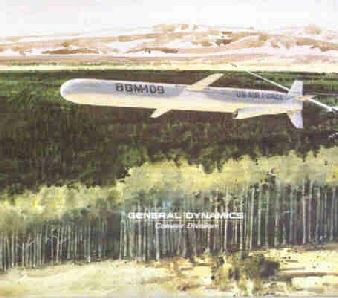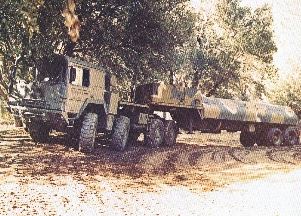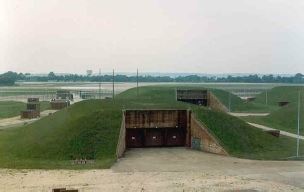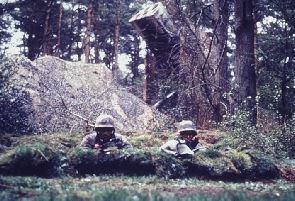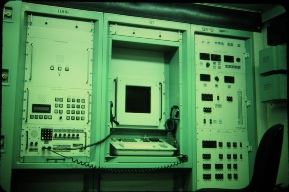| Ground Launched Cruise Missile (GLCM), BGM-109G, Gryphon Propulsion: One Williams International F107-WR-102 non-afterburning turbofan engine; one Atlantic Research solid-fuel rocket booster for launch Wingspan: 8 ft 7 in. Length: 18 ft 2 in, Diameter: 1 ft 9 in, Weight: 2,650 lbs. Speed: 500 mph, Range: 1,500 miles. Developed in the 1970s to provide the Air Force a highly mobile, reliable, precision-guided, ground-based system for delivering tactical thermonuclear warheads. Congress approved it on the contingency that it be an adaptation of the Navy's BGM-109 Tomahawk sea-launched cruise missile (SLCM), from General Dynamics. Guidance system manufactured by McDonnell Douglas Astronautics used terrain following radar and was extremely accurate. W-84 nuclear warhead. Air Force entered into cooperative effort with the Navy in the development of the missile. Deployed as a NATO system, with part of the security force from host nation forces. First launch from a TEL March 1980. Deployed to counter the Soviet medium range ballistic missile force deployed in Eastern Europe, GLCM was deactivated after the Intermediate Nuclear Force Treaty was signed, along with equivalent numbers of Soviet missiles. Photos - Left, General Dynamics concept of GLCM in flight, Transporter erector Launcher (TEL) Below, GAMA, deployed flight |
Weapon System Mobile launcher, or Transporter/Erector/Launcher (TEL), 56 feet long and 8 feet wide, weighed 80,000 pounds and carried 4 missiles. Mobile Launch Control Centerr (LCC) with two launch officers Deployment in flights comprised of 2 LCCs, 4 TELs, 16 support vehicles. Personnel included a flight commander, four launch officers, 19 maintenance specialists, 19 security specialists (a mix of US and host nation forces) and one medical technician. In peacetime, flights remained on bases in hardened shelters in the GLCM Alert and Maintenance Area (GAMA). During periods of increased tension, flights dispersed into the surrounding countryside and set up operation, digging in and hiding the flights in camouflage netting. Each flight commander had several classified preplanned locations for field deployment |
|
| Basing 501st Tactical Missile Wing (TMW), RAF Greenham Common, United Kingdom, with 96 missiles, the 11th Tactical Missile Squadron (TMS) and the 501st Tactical Missile Maintenance Squadron (TMMS), from 1 July 1982 to 31 May 1991. 487 TMW, Comiso AS, Italy (Sicily), 112 missiles, the 302 TMS and the 487 TMMS, from 30 June 1983 to 27 May 1991. Comiso was unique in that the first flight was trained together at Davis Monthan and Ft Huachuca for several months, then deployed in one group, complete with missiles and support equipment, by aircraft for Siciily, for immediate standup as an operational flight, in a project called Ready Merlin. 485 TMW, Florennes AB, Belgium, 48 missiles the 71 TMS and the 485 TMMS, from 1 August 1984 to 30 April 1989, 38 TMW, Wueschheim AB, Germany, 80 missiles, the 89 TMS and the 38 TMMS, from 1 April 1985 to 22 August 1990 303 TMW, RAF Molesworth, United Kingdom, 64 missiles, the 87 TMS and 303 TMMS, from 12 December 1986 to 31 January 1989 486 TMW, Woensdrecht, the Netherlands, 64 missiles The wing never achieved Initial Operational Capability and no tactical or maintenance squadrons were activated, from 27 August 87 to 30 September 1988 Photos - Left, Launch panel, launch from TEL. Below, TEL being erected |

